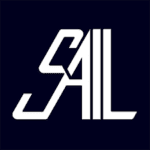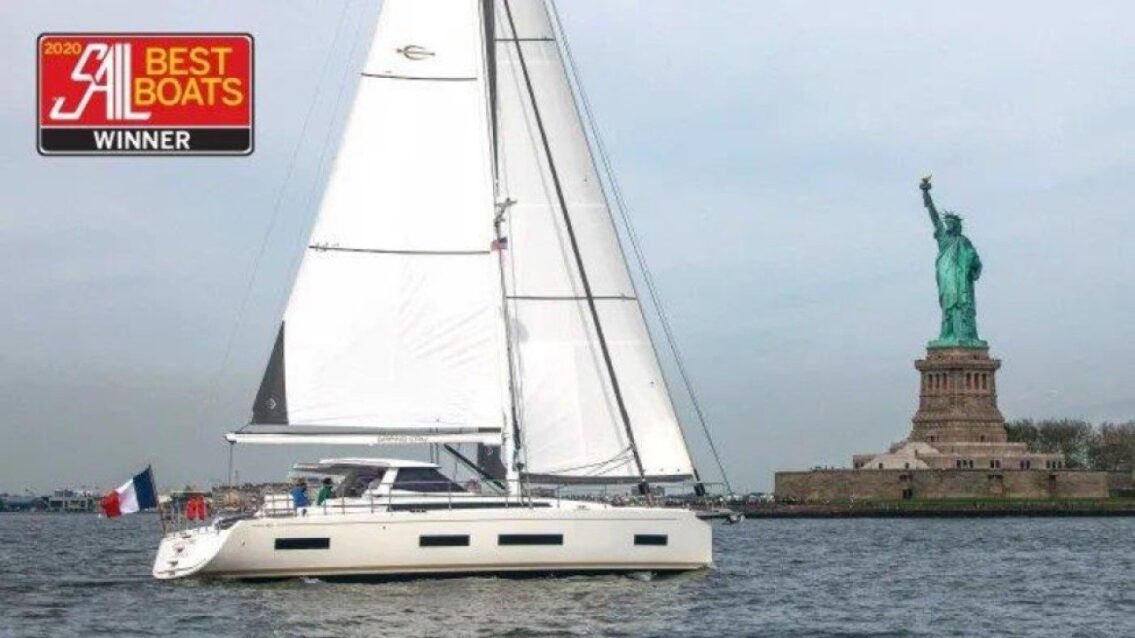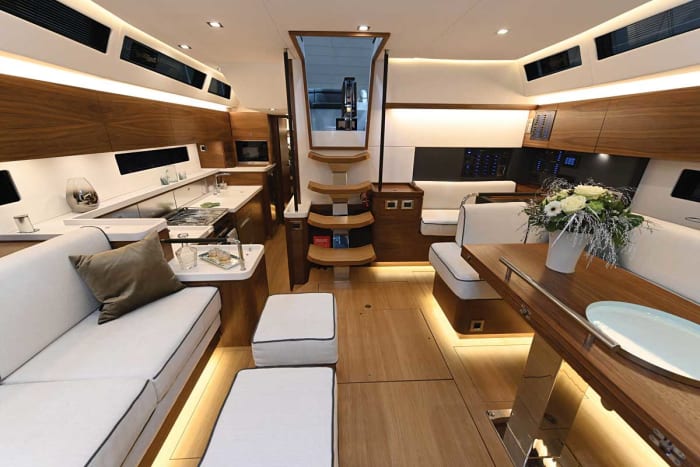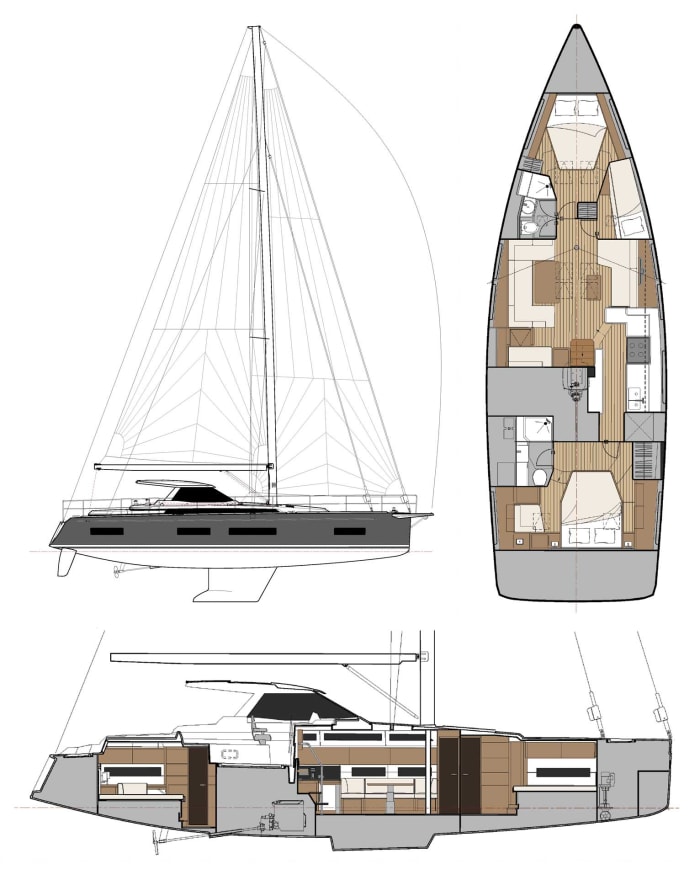Originally published June 21, 2021

It is possible to cross an ocean in almost anything that will float, just as you could cross the United States on anything with wheels. But to voyage safely, swiftly and comfortably calls for a good deal more than the minimum. That’s where bluewater specialist Amel comes into consideration with vessels like the new Amel 50, the smallest boat in the company’s current product line.
DESIGN & CONSTRUCTION
Over the past 50 years, Amel ketches like the Super Maramu have been top choices for sailors who value excellent construction, good open-water performance and a sensible layout for living aboard. The Amel 50 shares many of these qualities, but it’s a sloop, and its lines are also more modern, carrying a wider beam farther aft than its predecessors.
The Amel 50’s hull is vacuum-bagged with solid glass below the waterline and a foam core above. Close inspection of hidden areas reveals neatly finished work throughout. The system installations are meticulous. Wiring is conventional, not distributed, for reliability and easy maintenance. Twin rudders ensure a firm grip on the water at all angles of heel.
Amel believes in backing up the backups. If you manage to smash into something and flood both the forward and aft collision compartments, for example, you can move to the center of the boat and close the secondary watertight doors to the sleeping quarters, thus creating yet another set of collision compartments. You may not have a private cabin to nap in anymore, but you’ll still be afloat.
Easy maintenance was another priority when Amel created the 50. Experienced cruisers will all sprout big grins when they see the spacious engine room below the cockpit, the access hatches to all major systems, and the robust, simple construction that includes plenty of maintenance points within easy reach.
Other thoughtful touches include a clear plastic port under the aft berth that provides a direct view of the prop, a godsend when you need to check for fouling. Wiring is also all overhead behind removable panels, not hidden behind furniture or in the bilge. Speaking of the bilge, a pan collects shower and other gray water in one place at the foot of the companionway ladder, where it is then pumped out, thereby helping to keep the rest of the bilge that much cleaner.
ON DECK
The deck layout reflects the function of the Amel 50 as an offshore cruiser for shorthanded crews. Instead of a helm far aft in the open air, the wheel is located nearly amidships under an elegantly sculpted deckhouse. This reduces sail visibility somewhat but provides what will undoubtedly be much-appreciated protection from wind, rain and spray.
In fact, this kind of helm position and accompanying layout optimized for steering by autopilot rather than with the wheel is common on larger bluewater cruisers. However, skippers coming from smaller boats may need to adapt their thinking as they move up to this kind of vessel. The aim is comfort sailing hour after hour on passage, as opposed to continually tweaking course with every windshift.
Our test boat had a standard double-headsail rig, with a 135 percent genoa on the bow and a self-tacking inner jib, both on electric furlers. Over the years, this has proven a versatile combination for cruising. The in-mast mainsail furler was also electrically driven, and in light air, it was simply setting an asymmetric spinnaker on the combination sprit/anchor roller forward. With its 74ft mast and 7ft keel, the Amel 50 is not an ICW-style cruiser.
Although the boat can be managed almost entirely from the deckhouse, for those times when the crew still needs to go forward, Amel looks after their security with teak decks, strong grabrails and an exceptionally effective nonskid on all fiberglass surfaces.
ACCOMMODATIONS
Belowdecks, the interior layout is an unusual one in that the owner’s cabin is aft, and both it and the guest cabin forward come equipped with freestanding double berths. However, it’s an arrangement that makes sense for cruising, when the skipper needs to be within easy reach of the boat control center, even when off watch.
The saloon area is defined by a well-equipped inline galley to starboard and aft. While U-shaped galleys are the standard on American boats, this linear layout is arguably more efficient as long as it is possible for the cook to find something to brace up against when preparing meals underway. Forward of the galley is a settee with a U-shaped dinette to port. Aft of the dinette, a big navigation and electronics center creates a sort of mini-office, complete with a sizable desk.
UNDER SAIL
Unfortunately, the wind off Annapolis dropped from 8 to 5 to zero knots during our test sail. However, while not optimized for these conditions, the Amel 50 still acquitted itself well.
Sail raising and trimming were simple, thanks to a combination of good design and the boat’s substantial electric winches. The in-mast furling system worked smoothly, and the mainsail shape was satisfactory. Even the genoa car positions could be set under load from the cockpit, with electric winches once again doing the work.
I measured a 37-degree angle close-hauled to windward, and the boat tacked, jibed and executed all other standard maneuvers easily. The wheel gave accurate and sensitive feedback, and the pedestal-mounted helm seat was nice and comfy. The combination of easy motion and deliberate helm response gives the impression of a much larger vessel, more like a 75-footer than a boat with a 50ft LOA.
UNDER POWER
The diesel hummed gently behind heavy soundproofing to give us 6.8 knots at an easy 1,800 rpm. This is an often overlooked but important feature aboard a passagemaker, as a quiet ride is important to the well-being of the crew while motoring for long days through flat calms. The turning circle was 1.5 boatlengths, and the Amel 50 stopped easily and accurately. Backing showed a noticeable kick to port that only resolved itself when we picked up enough sternway for the rudders to take full effect. The bow thruster is a welcome accessory for docking.
CONCLUSION
If you are considering an extended cruise or voyage with your spouse or a couple of friends, the Amel 50 should be near the top of your shopping list. Any suitable boat you find in this category will be expensive, so you might as well go with one of the best.
Specifications
LOA 50ft 11in
LWL 47ft 8in
BEAM 15ft 8in
DRAFT 7ft
DISPLACEMENT 41,000lb
BALLAST 11,800lb
SAIL AREA 1346ft2 (100% foretriangle)
FUEL/WATER (GAL) 180/160
ENGINE 110hp
SA/D Ratio 18
D/L Ratio 169
Ballast Ratio 29



